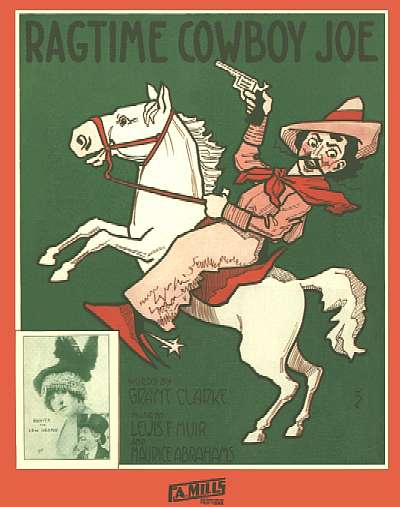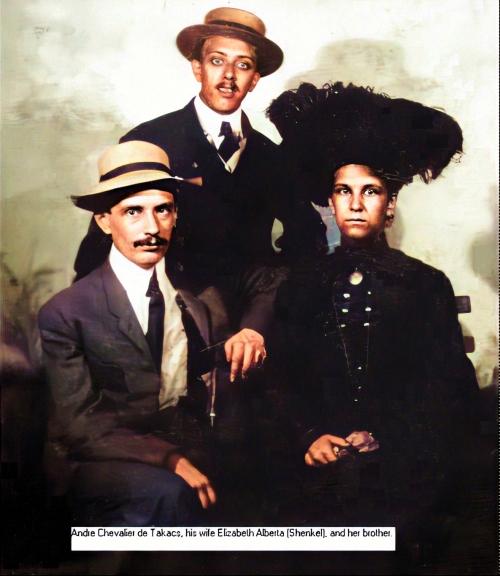
|
Andréa Stephen Chevalier De Takacs (June 15, 1880 to August 23, 1919) | |
 Selected Covers (Hover to View) Selected Covers (Hover to View) | |
|
My Pony Boy
Pork and Beans Put On Your Old Grey Bonnet Ragging the Scale (Original cover) Ragging the Scale (Common cover) Ragtime Cowboy Joe Rig-A-Ma-Role Rag She Used to Be the Slowest Girl in Town Shine On, Harvest Moon Somebody Else is Getting It That's-A-Plenty Traveling Waiting for the Robert E. Lee When I Marry You When Ragtime Rosie Ragged the Rosary | |
This unique illustrator and sometime composer was born in Hungary in 1880. His Hungarian father, Andrew De Takacs, who may also have been an artist, was a Hungarian Count. His mother was Helena Therese Chevalier (Bodnar) De Takacs. Andréa immigrated to America from Budapest, arriving June 11, 1901 on the Patricia from Hamburg, Germany. He soon became established as an artist in New York, although he had settled in nearby Hackensack, then Tenafly, New Jersey.
André, as he then referred to himself, started on a path that left a fascinating legacy of artwork,

 the majority of it on sheet music covers dating from 1906 to 1919. He is known to have illustrated at least two novels, and created some commercial art as well for both posters and postcards. André also wrote some poetry, and a few songs and song lyrics, for which he illustrated the covers, as might be expected. One was a poem My Sweetest Day, which was later set to music. He is mentioned in a few advertisements for publisher Jerome H. Remick, along with other fine composers associated with that firm.
the majority of it on sheet music covers dating from 1906 to 1919. He is known to have illustrated at least two novels, and created some commercial art as well for both posters and postcards. André also wrote some poetry, and a few songs and song lyrics, for which he illustrated the covers, as might be expected. One was a poem My Sweetest Day, which was later set to music. He is mentioned in a few advertisements for publisher Jerome H. Remick, along with other fine composers associated with that firm.


Two of André's songs included Silent Wooing and When Bessie Met the Bobby of Her Dreams was dedicated to his wife, Elizabeth "Bessie" Schenkel of Tenafly, New Jersey. She also posed for the cover art. André married her on November 20, 1902, just 17 months after arriving in the United States. Bessie was the granddaughter of locally famous violinist Leonard Schenkel who owned the Schenkel Inn in Tenafly, which her parents later ran as the Clinton Inn. She was used as a model for his covers from time to time. In a historical book on Tenafly by Eva Browning Sisson, she recounts the day that the electric trolley line first ran there in 1907. André was present at the inn which held a dinner in honor of the event, and he quickly sketched a drawing of the trolley and surrounding area, which was auctioned off for $20 to benefit the local fire department.
The De Takacs and Schenkel families moved over the next couple of years, and are shown in the 1910 census living with their two daughters Edythe H. (1905) and Bessie Elizabeth (1906), along with Bessie's recently widowed mother and her siblings in Palisades, New Jersey.
Although André contracted to a wide variety of publishers, a large volume of his work was featured on compositions published by the Jerome Remick Publishing Company and F.A. Mills. One piece about an elderly couple featured a drawing of the same on the cover, possibly André's parents, since the old man looks somewhat like André.
 |
There are indications that André may have been involved in the New York motion picture industry, perhaps as a set or art designer. He was known to have worked for Universal Film Company (predecessor to Universal Pictures) from 1916 to 1918. He lists them on his September 1918 draft record, indicating that he was working as an artist. During this period André would also refer to himself as "count" at least once in one novel that he illustrated. His unusual signature was modified several times during his career.
André De Takacs died suddenly on August 23, 1919 at the age of 39, his sad demise reportedly the result of a heart attack in a New York City taxicab en route to a hospital. The funeral notice in the New York Herald had an open invitation to "Members of the American Motion Picture Association" to attend. Bessie worked for several years as a telephone operator but had some financial troubles throughout the next several years. She followed André in 1927 by her own hand, committing suicide by ingesting mercury. Both are buried in Englewood, New Jersey. Their daughter Edythe (De Takacs) Jepsen became an artist in her own right, and was married to one as well, Paul Hilbert Jepsen. She lived into the 21st century, dying at age 101 in 2006.
De Takacs used lots of bold coloring in his work, such as in My Pony Boy, and was able to create both realistic images as well as pleasingly abstract ones. He was quite versatile with the "fade-away" technique, where the clothing or other portions of a subject is of the same color or pattern as the background, making the relevant portions stand out more while the rest of the figure fades into the background. View She Used to Be the Slowest Girl in Town and Somebody Else is Getting It for vivid examples of this technique.
Many thanks for additional information and verification go to Andrea Ellis who was named after her great grandfather, as well as Keith Emmons of HulaPages.Com. The last few years have been a voyage of discovery for her family as well in regards to André De Takacs' artistic legacy.